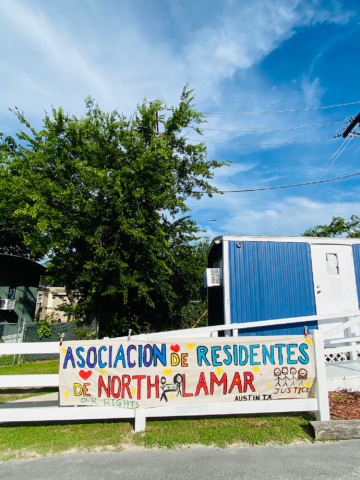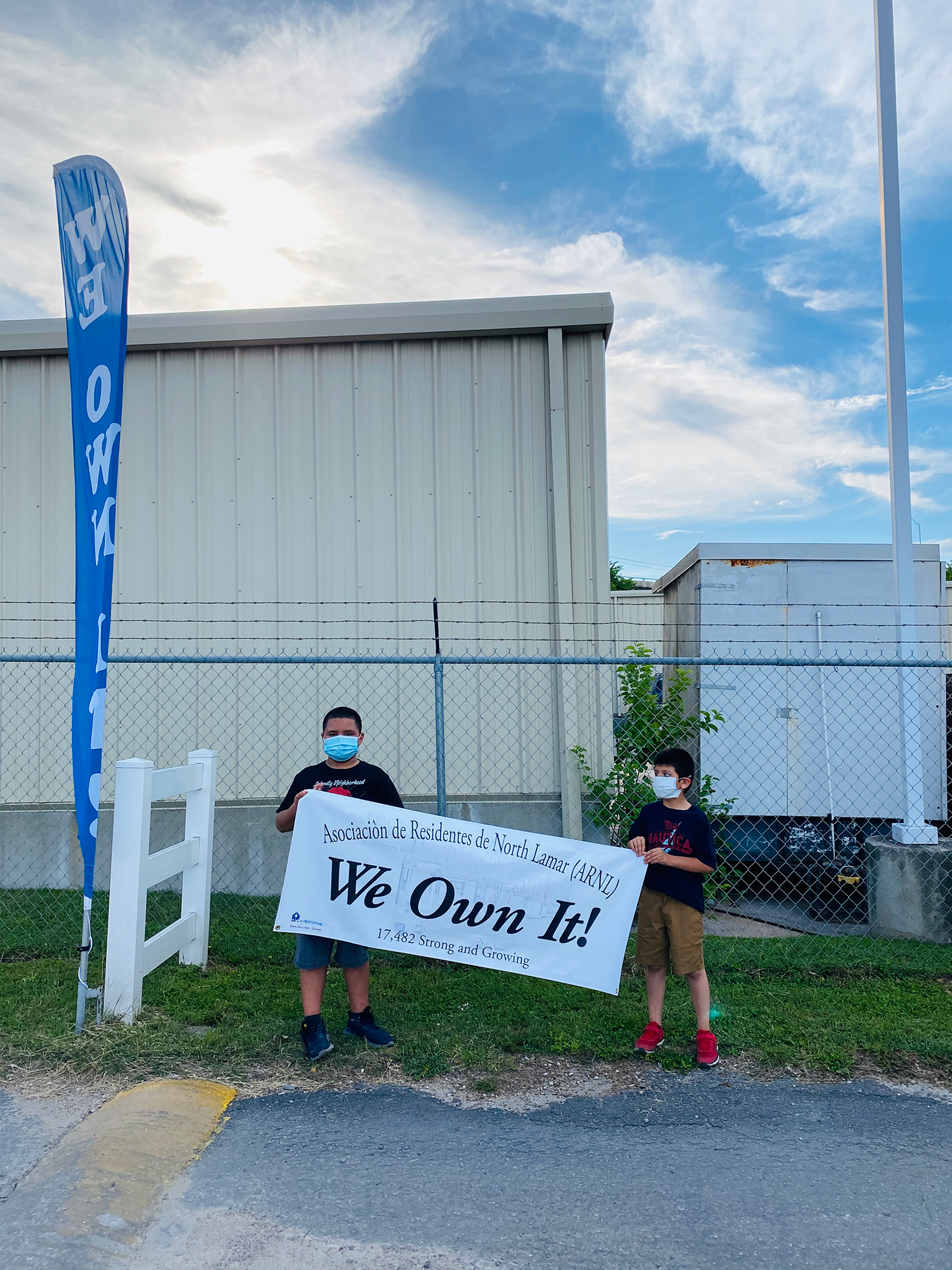Five years ago, facing significant rent increases and, in some cases, eviction, residents at the North Lamar Mobile Home Park organized. Now, they own the park.

By Megan Kimble
June 3, 2020
Roberto Sanchez brandishes a flashlight as he walks along the narrow street that loops through the North Lamar Mobile Home Park, a community of 68 homes tucked in the shadow of U.S. Highway 183 on Austin’s north side. It’s a Tuesday evening in late August, the summer sky still bright and clear. Overgrown trees crowd above the colorful trailers—peach, lime green, bright white—arranged neatly behind slatted wood fences and ceramic planters. But as night falls, Sanchez says, the street will become pitch black as residents return from their jobs building houses or busing tables—none of the streetlights work.
Sanchez leads a group of 40 residents and a dozen activists and journalists through the mobile home park on the Tour of Negligence and Neglect, the latest in a series of protests organized by the North Lamar Residents Association (known as ARNL, Asociación de Residentes de North Lamar). Uncollected trash spills into the street from an overflowing dumpster, attracting rats to nearby trailers.
“We’re not asking for special amenities, we are asking the owners of the mobile home park to ensure that the most basic services are provided,” says Sanchez, ARNL’s president, through an interpreter.
Residents have been fighting for basic services since 2015, when the mobile home park was purchased by investors Frank Rolfe and Dave Reynolds. Facing significant rent increases and, in some cases, eviction, residents organized. They called their city council member, the newly elected Gregorio Casar, and asked for help. Casar called Texas RioGrande Legal Aid, which in turn sued RV Horizons, the management company owned by Rolfe and Reynolds, for violating lease agreements. Residents were allowed to stay; rents increased, but more gradually.

“We managed to keep the community together but the question looming over everyone’s heads was: What happens next year?” Casar says. Until they owned the land they lived on, community members would always be vulnerable to the next round of rent increases.
All but one of the families living at North Lamar earn less than 60 percent of Austin’s median family income, or just under $57,000 for a family of four. Many earn far less. Only a handful of people in the predominantly immigrant community are bilingual. But residents—many of whom have lived at North Lamar for decades—have a distinct ability to rally people around their cause. As a result of ARNL’s initial organizing effort in 2015, the Austin City Council voted to fund a permanent tenant advocacy group called Building and Strengthening Tenant Action (BASTA).
“When we came into existence, we were able to support the residents to address their day-to-day concerns,” says Shoshana Kriegler, BASTA’s project director. “But the larger dream of owning the park and decommodifying the land, showing that there are alternative systems for housing, was something that was always present.”
Residents and BASTA began working toward that goal, and in November, a park maintenance employee tipped off ARNL that the property would soon be for sale. “We found out it was for sale and we went for it,” says Margarita Sanchez, Roberto’s wife and ARNL’s treasurer. “It’s hard to believe that we did it.”
On Friday, ARNL closed on a $7 million loan to purchase the mobile home park, becoming the second resident-owned mobile home park in Texas. Part of that funding, $2.5 million, came from the City of Austin’s 2018 affordable housing bond, which requires that the park remain as affordable housing for 99 years.
Like community land trusts, which separate the ownership of a home from the land beneath it, resident-owned mobile home cooperatives are part of a larger movement across the country seeking to create permanent models for affordable homeownership by focusing on land tenure—namely, who profits from the rising price of land as neighborhoods gentrify.
“A cooperative that is run by a longstanding immigrant community is the kind of model we need to start developing more of,” Casar says.

Eighteen million Americans live in manufactured housing, according to the U.S. Census, making it one of the largest sources of unsubsidized affordable housing in the United States. More than 7 percent of Texans, 1.9 million people, live in manufactured housing. As public housing stocks decline, “mobile homes are a primary way that America’s poor are housed,” writes Esther Sullivan in Manufactured Insecurity: Mobile Home Parks and Americans’ Tenuous Right to Place.
But what makes manufactured housing so affordable is precisely what makes it such an insecure form of housing. Despite the name, mobile homes are not actually mobile. More than 80 percent of manufactured homes never move once they’re set—relocations cost thousands of dollars and can cause structural damage—so residents often have no choice but to pay whatever a landlord is charging to lease the land underneath them.
“Residents who live there are in this hybrid situation, where they may own their homes outright, they may be purchasing their homes through formal financing or informal financing, but they don’t own the land,” says Frances Leos Martinez, a professor in the University of Texas School of Law who has worked with ARNL. “They are very vulnerable to the owners of those parks.”
Recognizing the potential of this captive market, private equity firms have started investing in manufactured housing communities, purchasing more than 150,000 home sites across the country since 2015, and aggressively raising rents and cutting costs to increase their profit margins. Frank Rolfe infamously compared owning a mobile home park to running “a Waffle House where the customers are chained to the booths.”
In 2015, after residents at North Lamar successfully sued RV Horizons, Rolfe told them that he’d sell them the park if they could access financing. “We said ‘That’s great, if you can buy it, by all means, do that,’” Rolfe tells the Observer. With his company’s investment of hundreds of thousands of dollars, Rolfe says he brought the park “back to life.”
Even as mobile home parks remain attractive purchases for investor groups—for $2,000 you can attend a three-day investor bootcamp through Rolfe’s Mobile Home University—they are vanishing across the state’s urban areas as rising land costs increase development pressure. In 2017, an Urban Institute report identified Austin’s 44 mobile home parks as vital protections for low-income people who otherwise could be displaced from the city. Meanwhile, in San Antonio, according to a recent UT report, at least nine of the city’s 97 mobile home parks have closed since 2014.

Since 2008, a nonprofit called ROC USA has helped homeowners in mobile home parks across the country form cooperatives and access financing so that they can buy the land they live on. In 2009, the nonprofit supported residents at Pasadena Trails, a 114-site mobile home park just outside of Houston, to purchase their park from an Arizona company. One of the first projects the residents tackled was drainage. “You would have these big puddles that everyone would have to try to walk through to get to the school bus,” says Mary O’Hara, the director of ROC USA Network. So the newly formed cooperative hired an engineer to redesign the property’s topography, finishing the project in July 2017. Two weeks later, when Hurricane Harvey hit, flooding manufactured housing communities across Houston, Pasadena Trails emerged without any standing water.
In 2016, residents at North Lamar invited O’Hara out for a visit. “When I got there, there were handmade signs lining the fence that said, ‘Welcome ROC USA, thank you ROC USA,’” O’Hara says. “No one had ever put up poster board signs for me.” A group of kids showed her around the community—this is where we play soccer, this is where the loud dog barks, they said—and by the end of the night, she was determined to help residents buy their community.
A 2010 study from the Carsey Institute at the University of New Hampshire found that mobile home residents who own their communities pay lower lot fees, have better access to low-interest financing, and have a much lower risk of displacement. Rents increase at a much slower pace—less than 1 percent annually at resident-owned communities versus 4 percent annually at commercially owned communities, according to a ROC USA audit.
In July, shortly before the Tour of Negligence and Neglect, Austin City Council rezoned North Lamar, along with eight other mobile home parks around the city, so that they would remain manufactured housing. “In our experience, if the property is going to remain a manufactured housing community, the residents can usually purchase it,” O’Hara says. “It’s when it’s priced for an alternative use that we have a hard time matching that price.”
Residents agreed to raise their monthly rents from $585 to $630 to help pay for the purchase. But ownership changes everything. ARNL’s loan financing includes $350,000 for infrastructure improvements—now residents can finally fix the street lights, cut back the trees, engineer new drainage. “We want to show that even though we are low-income we can make things better for our community,” Roberto says.
When Roberto bought their pistachio green trailer 19 years ago, his wife Margarita thought it was ugly—she didn’t want to live in a mobile home park. But back then, the lot fees were low enough that she could stay home to raise their four children while Roberto worked, so she acquiesced. “Looking back, those were the happiest years I’ve ever had,” she says. “I wouldn’t trade my mobile home for a normal house. There are always people here. That’s what makes it a home.”
“We like to party,” Roberto adds.
The COVID-19 pandemic prevented them from throwing a party to celebrate the purchase. Instead, residents climbed into their cars—decorated with balloons and washable paint—and rolled, honking and cheering, along the neighborhood’s one street. “Thanks for your support!” Roberto yelled into a bullhorn. Two young kids walked slowly forward, holding a white banner between them, reading: Asociación de Residentes de North Lamar: We Own It!
Read more from the Observer:
The Protests Against Police Brutality in Texas, in Photos: Demonstrations against police brutality are taking place in cities large and small across Texas.
‘Heroes’ No More: Grocers Are Already Clawing Back COVID-19 Worker Benefits: Kroger revoked its “Hero Pay” in May, while public health experts warn of COVID-19 surges as Texas reopens.
Dallas County Judge Clay Jenkins on Battling COVID-19, and the Governor, as Texas Reopens: “Now we’re just working with this unprecedented state usurpation of local control, trying to keep people safe as best we can.”







